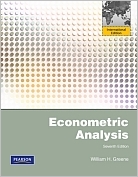This text serves as a bridge between an introduction to the field of
econometrics and the professional literature for graduate students in the social sciences,
focusing on applied econometrics and theoretical concepts.
Table of Contents
Part I: The Linear Regression Model
Chapter 1: Econometrics
Chapter 2: The Linear Regression Model
Chapter 3: Least Squares
Chapter 4: The Least Squares Estimator
Chapter 5: Hypothesis Tests and Model Selection
Chapter 6: Functional Form and Structural Change
Chapter 7: Nonlinear, Semiparametric, and Nonparametric Regression Models
Chapter 8: Endogeneity and Instrumental Variable Estimation
Part II: Generalized Regression Model and Equation Systems
Chapter 9: The Generalized Regression Model and Heteroscedasticity
Chapter 10: Systems of Equations
Chapter 11: Models for Panel Data
Part III: Estimation Methodology
Chapter 12: Estimation Frameworks in Econometrics
Chapter 13: Minimum Distance Estimation and the Generalized Method of Moments
Chapter 14: Maximum Likelihood Estimation
Chapter 15: Simulation-Based Estimation and Inference
Chapter 16: Bayesian Estimation and Inference
Part IV: Cross Sections, Panel Data, and Microeconometrics
Chapter 17: Discrete Choice
Chapter 18: Discrete Choices and Event Counts
Chapter 19: Limited Dependent Variables—Truncation, Censoring, and Sample Selection
Part V: Time Series and Macroeconometrics
Chapter 20: Serial Correlation
Chapter 21: Models with Lagged Variables
Chapter 22: Time-Series Models
Chapter 23: Nonstationary Data
Part VI: Appendices
Appendix A: Matrix Algebra
Appendix B: Probability and Distribution Theory
Appendix C: Estimation and Inference
Appendix D: Large-Sample Distribution Theory
Appendix E: Computation and Optimization
Appendix F: Data Sets Used in Applications
Appendix G: Statistical Tables
1248 pages , Paperback


